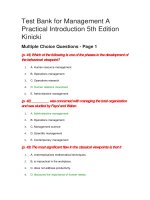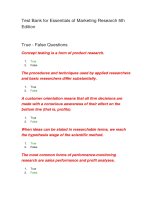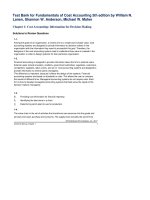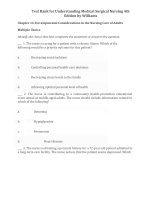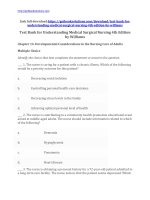Test bank for thelans critical care nursing 5th edition (chapters 2 42) by urden
Bạn đang xem bản rút gọn của tài liệu. Xem và tải ngay bản đầy đủ của tài liệu tại đây (43.21 KB, 7 trang )
Full file at />
Urden: Thelan’s Critical Care Nursing, 5th Edition
Test Bank
Chapter 2: Ethical Issues
MULTIPLE CHOICE
1.
a.
b.
c.
d.
The difference between morals and ethics is that ethics
is more concerned with the “why” of behavior.
distinguishes the good or right in conduct.
is broader in scope.
concentrates on the right or wrong of behavior.
ANS: A
Ethics is concerned with the “why” of the action; morals are concerned with whether the action
is right or wrong.
DIF: Cognitive Level: Comprehension REF: 14
OBJ: Nursing Process Step: General
TOP: Ethics
MSC: NCLEX: Safe and Effective Care Environment
2.
a.
b.
c.
d.
The critical care nurse can best enhance the principle of autonomy by
allowing the patient to do as much for himself or herself as possible.
assisting with only those tasks that cannot be done by the patient.
providing the patient with all information and facts.
guiding the patient toward the best choices for care.
ANS: C
Patients and families must have all the information about a certain situation to make an
autonomous decision that is best for them.
DIF: Cognitive Level: Synthesis
REF: 15
OBJ: Nursing Process Step: General
TOP: Ethics
MSC: NCLEX: Safe and Effective Care Environment
3. Which of the following ethical principles is most important when soliciting informed consent
from a patient?
a. Nonmaleficence
b. Fidelity
c. Beneficence
d. Veracity
ANS: D
buy this full document at
Full file at />Veracity is truth-telling and is important in soliciting informed consent.
DIF: Cognitive Level: Comprehension REF: 16
OBJ: Nursing Process Step: General
TOP: Ethics
MSC: NCLEX: Safe and Effective Care Environment
4. Which statement best reflects the concept of allocation of resources within the critical care
setting?
a. Limitations of resources force reexamination of goals of critical care for patients.
b. Care is provided equally to all those who need the resources.
c. Equal access is available for those with the same condition or diagnosis.
d. Technologic advances are available to most of those in a given community.
ANS: A
Limited resources force society and critical care health practitioners to reexamine goals of
critical care for patients.
DIF: Cognitive Level: Comprehension REF: 16
OBJ: Nursing Process Step: General
TOP: Ethics
MSC: NCLEX: Safe and Effective Care Environment
5.
a.
b.
c.
d.
When deciding whether to withdraw or withhold treatment, it is important to
examine one's own beliefs to guide the family to a correct decision.
approach the family with honesty and provide clear information.
simply follow the advance directive if available.
allow the physician to approach the family.
ANS: B
This is a difficult time for family members, and the nurse will need to be attuned to listening and
providing needed information.
DIF: Cognitive Level: Knowledge
REF: 17
OBJ: Nursing Process Step: General
TOP: Ethics
MSC: NCLEX: Safe and Effective Care Environment
6. The Code of Ethics for Nursing provides a framework for the nurse in ethical decision
making. This code
a. is usurped by state or federal laws.
b. allows the nurse to focus on the good of society rather than the uniqueness of the
patient.
c. was recently adopted by the American Nurses Association.
d. describes the nurse's role in advocating for patient rights and safety.
buy this full document at
Full file at />ANS: D
The Code of Ethics for Nursing describes the professional role of the nurse in advocating for and
protecting patients' rights to health and safe care.
DIF: Cognitive Level: Comprehension REF: 17
OBJ: Nursing Process Step: General
TOP: Ethics
MSC: NCLEX: Safe and Effective Care Environment
7.
a.
b.
c.
d.
Ethical decisions are best made by
following the guidelines of a framework or model.
having the patient discuss alternatives with the physician or nurse.
prioritizing the greatest good for the greatest number of persons
careful consideration by the medical team once all diagnostic data are reviewed.
ANS: A
To facilitate the ethical decision-making process, a model or framework must be used so that all
involved will consistently and clearly examine the multiple ethical issues that arise in critical
care.
DIF: Cognitive Level: Comprehension REF: 18
OBJ: Nursing Process Step: General
TOP: Ethics
MSC: NCLEX: Safe and Effective Care Environment
8.
a.
b.
c.
d.
The first step of the ethical decision-making process is
consulting with an authority.
identifying the health problem.
delineating the ethical problem from other types of problems.
identifying the patient as the primary decision maker.
ANS: B
Step one involves identifying the major aspects of the patient's medical and health problems.
DIF: Cognitive Level: Knowledge
REF: 18
OBJ: Nursing Process Step: General
TOP: Ethics
MSC: NCLEX: Safe and Effective Care Environment
9. Values clarification can assist the patient to clarify his or her own values to facilitate effective
decision making. Which of the following nursing activities is incorporated into this
intervention?
a. Avoid the use of open-ended questions.
b. Use multiple sessions to cross-examine the patient to ensure he or she is clear
about personal values.
c. Use appropriate questions to assist the patient in reflecting on the situation and
buy this full document at
Full file at />what is personally important.
d. Encourage members of the health care team to relate how they would make the
decision.
ANS: C
Use appropriate questions to assist the patient in reflecting on the situation and what is
personally important.
DIF: Cognitive Level: Comprehension
OBJ: Nursing Process Step: General
MSC: NCLEX: Psychosocial Integrity
10.
a.
b.
c.
d.
REF: 19
TOP: Ethics
Nursing ethics committees often differ from institutional ethics committees in what way?
They do not involve specific patient situations.
Their recommendations for action are binding.
Staff education is an important component.
Their primary role is to create policies for the hospital on ethical issues.
ANS: C
Nursing ethics committees provide a forum for nurses to discuss various ethical issues, serve as a
staff resource, and provide education.
DIF: Cognitive Level: Knowledge
REF: 20
OBJ: Nursing Process Step: General
TOP: Ethics
MSC: NCLEX: Safe and Effective Care Environment
11.
a.
b.
c.
d.
Which of the following is NOT a criteria for defining an ethical dilemma?
An awareness of different options exists.
An issue in which only one viable option exists.
The choice of one option compromises the option not chosen.
An issue that has different options.
ANS: B
The criteria for identifying an ethical dilemma is threefold: (1) an awareness of the different
options, (2) an issue that has different options, and (3) the choice of one option over another
compromises the option not chosen.
DIF: Cognitive Level: Knowledge
REF: 18
OBJ: Nursing Process Step: Assessment TOP: Ethics
MSC: NCLEX: Safe and Effective Care Environment
12. If a treatment achieves a predictable outcome then, by definition, it is NOT futile.
a. True
buy this full document at
Full file at />b. False
ANS: B
Unless the treatment has shown some benefit to the patient, despite having achieved the
predicted outcome the treatment is still deemed futile.
DIF: Cognitive Level: Knowledge
REF: 17
OBJ: Nursing Process Step: General
TOP: Ethics
MSC: NCLEX: Safe and Effective Care Environment
MATCHING
Match the following terms with their definitions:
a. BENEFICENCE
b. VERACITY
c. JUSTICE
d. OBJECTIVITY
e. SUBJECTIVITY
1. Synonymous with the concept of allocation of resources
2. Analyzes a person’s psychosocial state
3. Preventing harm and promoting the well-being of patients
4. Examining a person’s ability to function
5. Telling the truth
1. ANS: C
DIF: Cognitive Level: Knowledge
OBJ: Nursing Process Step: General
TOP: Ethics
MSC: NCLEX: Safe and Effective Care Environment
REF: 15-16
2. ANS: E
DIF: Cognitive Level: Knowledge
OBJ: Nursing Process Step: General
TOP: Ethics
MSC: NCLEX: Safe and Effective Care Environment
REF: 15-16
3. ANS: A
DIF: Cognitive Level: Knowledge
OBJ: Nursing Process Step: General
TOP: Ethics
MSC: NCLEX: Safe and Effective Care Environment
REF: 15-16
buy this full document at
Full file at />4. ANS: D
DIF: Cognitive Level: Knowledge
OBJ: Nursing Process Step: General
TOP: Ethics
MSC: NCLEX: Safe and Effective Care Environment
REF: 15-16
5. ANS: B
DIF: Cognitive Level: Knowledge
OBJ: Nursing Process Step: General
TOP: Ethics
MSC: NCLEX: Safe and Effective Care Environment
REF: 15-16
SHORT ANSWER
1. __________ and __________ are both elements of the ethical principle of fidelity.
ANS:
Confidentiality, privacy
Rationale: Confidentiality refers to the nurse’s duty to protect patient information and privacy,
though closely related, usually refers to the patient’s physical person.
DIF: Cognitive Level: Comprehension
OBJ: Nursing Process Step: General
MSC: NCLEX: Psychosocial Integrity
REF: 16
TOP: Ethics
2. Place the following steps in ethical decision making in the order in which they should be
carried out:
a. Identify the health problem.
b. Implement decisions.
c. Identify the decision maker.
d. Define the ethical issue.
e. Evaluate actions and decisions.
f. Gather additional information.
g. Examine moral and ethical principles.
h. Explore alternative options.
ANS:
a, d, f, c, g, h, b, e
Rationale: The steps in ethical decision making mirror those in the nursing process.
DIF: Cognitive Level: Synthesis
REF: 18
OBJ: Nursing Process Step: General
TOP: Ethics
MSC: NCLEX: Safe and Effective Care Environment
3. A professional ethic is based on three elements: __________, __________, and __________.
buy this full document at
Full file at />ANS:
the professional code of ethics, the purpose of the profession, the standards of practice of the
profession
Rationale: The three elements that are the bases for a professional ethic are the existence of a
professional code of ethics, a defined professional purpose, and an identified standard of
practice.
DIF: Cognitive Level: Comprehension REF: 17
OBJ: Nursing Process Step: General
TOP: Ethics
MSC: NCLEX: Safe and Effective Care Environment
buy this full document at

